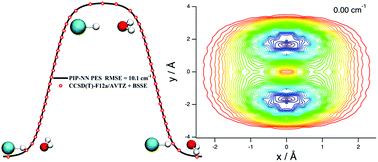HCl–H2O dimer: an accurate full-dimensional potential energy surface and fully coupled quantum calculations of intra- and intermolecular vibrational states and frequency shifts†
Abstract
The interaction between HCl and H2O is of considerable theoretical and experimental interest due to its important role in atmospheric chemistry and understanding the onset of the dissociation of HCl in water. In this work, the HCl–H2O complex is quantitatively characterized in two ways. First, we report a new full-dimensional potential energy surface (PES) for the HCl + H2O system. The nine-dimensional (9D) PES is based on circa 43 000 ab initio points calculated at the level of CCSD(T)-F12a/AVTZ with the basis set superposition error correction using the permutation invariant polynomial-neural network method, which can accurately and efficiently reproduce the geometries, energies, frequencies of the complex of HCl with H2O, as well as the relevant minimum energy path. Next, we present the results of the first fully coupled 9D quantum calculations of the intra- and intermolecular vibrational states of the HCl–H2O dimer, performed on the new PES. They employ the highly efficient bound-state methodology previously used to compute accurately the rovibrational level structure of the H2O/D2O–CO and HDO–CO complexes [P. M. Felker and Z. Bačić, J. Chem. Phys., 2020, 153, 074107; J. Phys. Chem. A, 2021, 125, 980]. The 9D calculations characterize the vibrationally averaged nonplanar ground-state geometry of the HCl–H2O complex, the intramolecular vibrational fundamentals of both H2O and HCl moieties, and their frequency shifts, as well as the low-energy intermolecular vibrational states in each of the intramolecular vibrational manifolds and the effects of the coupling between the two sets of modes. The calculated properties of the HCl–H2O dimer are in excellent agreement with the available spectroscopic data. The 9D computed dimer binding energy D0 of 1334.63 cm−1 agrees extremely well with the experimental D0 equal to 1334 ± 10 cm−1 [B. E. Casterline and A. K. Mollner and L. C. Ch'ng and H. Reisler, J. Chem. Phys., 2010, 114, 9774]. Moreover, the ground-state expectation value of the out-of-plane bend angle of H2O, 33.80°, and the computed HCl stretch frequency shift, −157.9 cm−1, both from the 9D calculations, are in very good accord with the corresponding experimental values.

- This article is part of the themed collections: 2021 PCCP HOT Articles and Emerging AI Approaches in Physical Chemistry


 Please wait while we load your content...
Please wait while we load your content...